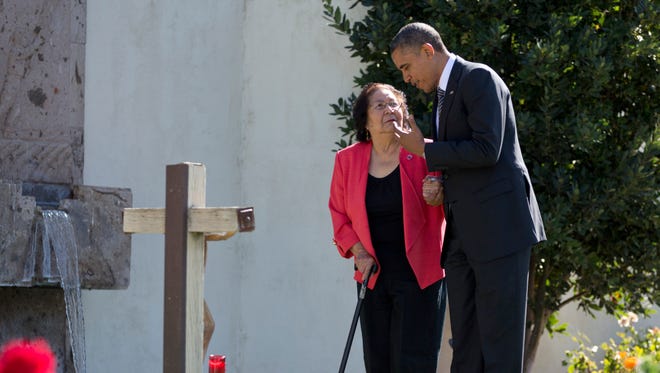Obama’s national monuments are about more than conservation

WASHINGTON — Using his authority under the 1906 Antiquities Act more frequently than any president in history, President Obama has set aside more than 3.9 million acres of land for federal protection.
But Obama's 23 proclamations creating new national monuments are about more than conservation. More than any other president, he's also used them as a way to recognize formerly underappreciated chapters of American history — and to appease constituent groups with a mostly symbolic and low-cost presidential proclamation.
The designation of Christopher Park in New York City Friday was just such a proclamation. With the stroke of a pen, Obama protected the seven-acre park from development and renamed it the Stonewall National Monument — paying homage to the Stonewall riots that happened across the street in 1968, launching the modern gay rights movement.
That he did it during a month he had already proclaimed as Gay Pride Month — and just two weeks after a mass shooting at a gay nightclub in Orlando — gave it added significance.
"Stonewall will be our first national monument to tell the story of the struggle for LGBT rights," Obama said Saturday in his weekly radio address. "I believe our national parks should reflect the full story of our country — the richness and diversity and uniquely American spirit that has always defined us."
Obama designates national gay rights monument
Over the last five years, Obama has signed similar proclamations to recognize sites important to Latinos, labor unions, African Americans, Japanese Americans, and women.
"Every president has used the Antiquities Act, and some have used it more than others," said Theresa Pierno, president of the National Parks Conservation Association, an independent parks advocacy group. "But it is very different, what Obama has done. You've started to see his protection of parks that tell very important stories that have been neglected in our history."
30 visits and counting: Obama uses presidency to promote national parks
Those stories include:
► The Cesar Chavez National Monument in California, proclaimed in 2011, which recognized the place where Latino labor leader lived and worked.
► The Harriet Tubman National Monument in Maryland (2013), which contains a number of historic sites important to the early life of the African-American abolitionist leader.
► The Charles Young Buffalo Soldiers National Monument in Ohio (2013), the home of the Army colonel who led all-black regiments and was the highest-ranking African-American in the military during his lifetime.
► The Honouliuli National Monument in Hawaii (2015), an internment camp for Japanese Americans during World War II.
► The Pullman National Monument in Illinois (2015), which was ground zero for the 19th century railway labor strike that inspired Congress to declare the Labor Day holiday.
► The Belmont-Paul Women’s Equality National Monument in Washington (2016) was the place where suffragist leader Alice Paul led the National Women's Party.
Each of the proclamations establishing those monuments provided Obama with an opportunity to speak more directly to the largely Democratic constituent groups whose history he was recognizing.
That's no happy coincidence, said Brandon Rottinghaus, a University of Houston professor who studies presidential proclamations. For Democratic presidents, it can be difficult to live up to the expectations of the increasingly diverse minority groups that elect them. "This is a low-cost way for the president to keep the dialogue open," he said.
Obama isn't acting completely without precedent. Previous presidents have used the Antiquities Act to recognize historical sites important to military and veterans groups, conservationists, and American Indian tribes.
And while Congress still has its own ability to declare monuments under the Antiquities Act, Obama has chosen to exercise the presidential authority first granted to President Theodore Roosevelt.
Like executive orders, Obama's monument proclamations change the status quo and force Congress to respond. "In effect, presidents establish these monuments, then force Congress to find funds for the maintenance or preservation of the monument," Rottinghaus said. "Congress is put in the position of having to either not fund the monument and explain why or fund it."
Congress has voted 11 times to abolish national monuments, but only once in the past 50 years. And the cost of historic sites like Stonewall is relatively small. All of the land is already under the control of the federal government, and the National Parks Service is raising private donations to help improve and maintain the site.
Still, Republicans have complained that Obama has used the Antiquities Act to short-circuit the legislative process. In many cases — including Stonewall — there was already legislation pending that would have designated the monument, often under different conditions.
Most of the Republican opposition has come to large-scale designations in the rural West. After Obama protected 330,000 acres in California last year, Rep. Doug LaMalfa, R-Calif., said the move "exemplifies the president's complete disregard for the legislative process and his lack of hesitance on using every single political tool to carry out even more of his executive power grabs."
Republicans want more local consultation before the president designates new monuments. Last year, the House voted 222-206 to approve an amendment that would prohibit the president from designating national monuments where there's significant local opposition. The bill died, however, and even if it were to pass it wouldn't likely effect the historical sites Obama has designated.
"The Antiquities Act is a very important tool that presidents have had since Theodore Roosevelt. It's been used, I would argue, sparingly and carefully," Interior Secretary Sally Jewell told a Senate Committee earlier this year. "I will say that he has used it 22 times in his administration. In every case we have had engagement on the ground in the communities to understand everybody's opinions. I've been to many of those meetings. They have never been unanimous, but they have also always provided a good balance."

